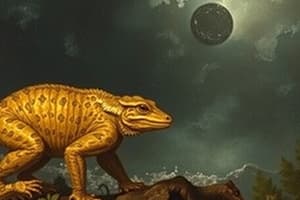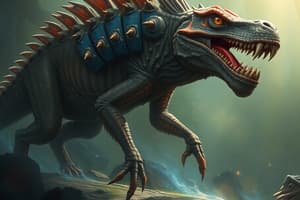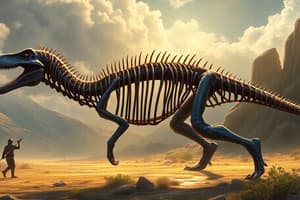Podcast
Questions and Answers
Which of the following clades is NOT a modern clade of Sarcopterygii?
Which of the following clades is NOT a modern clade of Sarcopterygii?
- Chondrichthyes (correct)
- Actinistia
- Tetrapoda
- Dipnoi
Tetrapods have only one set of limbs.
Tetrapods have only one set of limbs.
False (B)
What are the major bones found in the hindlimb of tetrapods?
What are the major bones found in the hindlimb of tetrapods?
Femur, tibia, fibula, pes
The major components of the appendicular skeleton include __________ and girdles.
The major components of the appendicular skeleton include __________ and girdles.
Match the following adaptations with their corresponding environmental scenarios:
Match the following adaptations with their corresponding environmental scenarios:
What does positive allometry indicate in scaling relationships?
What does positive allometry indicate in scaling relationships?
Negative allometry means that one measure scales less than expected compared to another.
Negative allometry means that one measure scales less than expected compared to another.
What is isometry in the context of scaling relationships?
What is isometry in the context of scaling relationships?
In biology, expected scaling relationships for length with mass is given by L ∝ M^[______].
In biology, expected scaling relationships for length with mass is given by L ∝ M^[______].
Match the following scaling relationships with their respective power law expressions:
Match the following scaling relationships with their respective power law expressions:
Which of the following statements about scaling relationships is true?
Which of the following statements about scaling relationships is true?
The expected scaling relationship for area with mass is A ∝ M^{1/3}.
The expected scaling relationship for area with mass is A ∝ M^{1/3}.
What is the expected slope for mass vs mass in scaling relationships?
What is the expected slope for mass vs mass in scaling relationships?
What is one advantage of larger body size in vertebrates?
What is one advantage of larger body size in vertebrates?
Larger body sizes in vertebrates always reduce the effects of gravity.
Larger body sizes in vertebrates always reduce the effects of gravity.
Name one primary challenge larger vertebrates face due to their size.
Name one primary challenge larger vertebrates face due to their size.
Transitions between aquatic and terrestrial habitats necessitate changes in ______.
Transitions between aquatic and terrestrial habitats necessitate changes in ______.
Match the following adaptations with their corresponding environments:
Match the following adaptations with their corresponding environments:
What physical constraint must body plans of vertebrates adhere to?
What physical constraint must body plans of vertebrates adhere to?
All vertebrates have the same body plan regardless of their environment.
All vertebrates have the same body plan regardless of their environment.
Explain what is meant by isometry in scaling relationships.
Explain what is meant by isometry in scaling relationships.
Changes in ________ can be a result of scaling and adaptation to environmental challenges.
Changes in ________ can be a result of scaling and adaptation to environmental challenges.
Match the following concepts with their respective definitions:
Match the following concepts with their respective definitions:
What is the relationship between volume (V) and length (L)?
What is the relationship between volume (V) and length (L)?
In biology, the scaling factor k affects both structure and function as the organism grows.
In biology, the scaling factor k affects both structure and function as the organism grows.
What is the formula to express area (A) in terms of length (L) in this context?
What is the formula to express area (A) in terms of length (L) in this context?
The relationship A ∝ L^2 implies that area scales with the ___ of the organism.
The relationship A ∝ L^2 implies that area scales with the ___ of the organism.
Match the following scaling relationships with their corresponding areas:
Match the following scaling relationships with their corresponding areas:
Which scaling relationship is correct when considering physical constraints on body plans?
Which scaling relationship is correct when considering physical constraints on body plans?
The formula V2 = (2L)^3 suggests that doubling a dimension quadruples the volume.
The formula V2 = (2L)^3 suggests that doubling a dimension quadruples the volume.
Which feature is NOT part of the vertebrate body plan (bauplan)?
Which feature is NOT part of the vertebrate body plan (bauplan)?
What effect does isometry have on relationships between body mass and proportions?
What effect does isometry have on relationships between body mass and proportions?
In a logarithmic scale, a multiplicative series is converted into an ___ relationship.
In a logarithmic scale, a multiplicative series is converted into an ___ relationship.
The hourglass model suggests that vertebrate embryos show morphological diversity initially and then converge towards a conserved body plan.
The hourglass model suggests that vertebrate embryos show morphological diversity initially and then converge towards a conserved body plan.
Which of the following best describes the effect of scaling on physical measures in tetrapods?
Which of the following best describes the effect of scaling on physical measures in tetrapods?
Name the two main clades of bony fishes.
Name the two main clades of bony fishes.
The _____ are the earliest bony fishes known from the Late Silurian period, approximately 425 million years ago.
The _____ are the earliest bony fishes known from the Late Silurian period, approximately 425 million years ago.
Match the following vertebrate groups with their characteristics:
Match the following vertebrate groups with their characteristics:
Which statement accurately describes the muscles of Actinopterygii?
Which statement accurately describes the muscles of Actinopterygii?
All vertebrates have a fully ossified endoskeleton.
All vertebrates have a fully ossified endoskeleton.
What do the paired pectoral and pelvic fins signify in vertebrate evolution?
What do the paired pectoral and pelvic fins signify in vertebrate evolution?
The most diverse vertebrate clade, comprising 50% of all vertebrates, is _____.
The most diverse vertebrate clade, comprising 50% of all vertebrates, is _____.
Which physical constraint is important for the body plan of aquatic vertebrates?
Which physical constraint is important for the body plan of aquatic vertebrates?
Which of the following features is characteristic of the skulls of early tetrapods?
Which of the following features is characteristic of the skulls of early tetrapods?
Modern amphibians have retained all the bones present in early tetrapod skulls.
Modern amphibians have retained all the bones present in early tetrapod skulls.
What type of skull structure do turtles exhibit, reverting to an anapsid condition?
What type of skull structure do turtles exhibit, reverting to an anapsid condition?
The diapsid skull of snakes shows extreme loss of bone, particularly __________.
The diapsid skull of snakes shows extreme loss of bone, particularly __________.
Match the following reptiles with their skull characteristics:
Match the following reptiles with their skull characteristics:
Which bone structure in the skull is often not ossified in modern amphibians?
Which bone structure in the skull is often not ossified in modern amphibians?
Aves have a heavier skull compared to their early ancestors to support flight.
Aves have a heavier skull compared to their early ancestors to support flight.
What unique feature do monotremes like the Echidna possess regarding their teeth?
What unique feature do monotremes like the Echidna possess regarding their teeth?
Which part of the skull primarily protects the brain in tetrapods?
Which part of the skull primarily protects the brain in tetrapods?
The splanchnocranium is primarily responsible for supporting the jaw.
The splanchnocranium is primarily responsible for supporting the jaw.
What are the temporal fenestrae?
What are the temporal fenestrae?
The ____ is a type of cavity or shallow depression found in skull anatomy.
The ____ is a type of cavity or shallow depression found in skull anatomy.
Match the following types of skull modifications to their descriptions:
Match the following types of skull modifications to their descriptions:
Which characteristic distinguishes diapsid skulls from synapsid skulls?
Which characteristic distinguishes diapsid skulls from synapsid skulls?
All tetrapods have a uniform skull structure regardless of their evolutionary lineage.
All tetrapods have a uniform skull structure regardless of their evolutionary lineage.
What role do fontanels play in newborn humans?
What role do fontanels play in newborn humans?
The ____ is the part of the skull that consists of dermal bone, including the skull roof and facial bones.
The ____ is the part of the skull that consists of dermal bone, including the skull roof and facial bones.
What are the two major components found in the skull of humans?
What are the two major components found in the skull of humans?
All mammals, including humans, have more than 7 cervical vertebrae.
All mammals, including humans, have more than 7 cervical vertebrae.
Which mammal is known to have more than 7 cervical vertebrae?
Which mammal is known to have more than 7 cervical vertebrae?
Elasmosaurids are notable for having the most _______ and the longest necks among vertebrates.
Elasmosaurids are notable for having the most _______ and the longest necks among vertebrates.
Match the anatomical feature to the corresponding group of animals:
Match the anatomical feature to the corresponding group of animals:
Which of the following bones is NOT part of the modern mammalian skull?
Which of the following bones is NOT part of the modern mammalian skull?
All reptile skulls have the same amount of fenestrae.
All reptile skulls have the same amount of fenestrae.
Name two major anatomical features that differentiate the neurocranium from the splanchnocranium.
Name two major anatomical features that differentiate the neurocranium from the splanchnocranium.
Tetrapods evolved from fish-like ancestors with significant changes in skull morphology, particularly in the development of __________.
Tetrapods evolved from fish-like ancestors with significant changes in skull morphology, particularly in the development of __________.
Match the following amphibian skull features with their descriptions:
Match the following amphibian skull features with their descriptions:
Which of the following is a characteristic feature of diapsid skulls?
Which of the following is a characteristic feature of diapsid skulls?
Certain skull bones in mammals have been repurposed into the ear bones.
Certain skull bones in mammals have been repurposed into the ear bones.
What is the primary adaptation of the Dasypeltis skull for its diet?
What is the primary adaptation of the Dasypeltis skull for its diet?
What term describes the junctions between the bones of the skull?
What term describes the junctions between the bones of the skull?
The term __________ refers to the evolutionary process of gaining and losing anatomical features in skulls over time.
The term __________ refers to the evolutionary process of gaining and losing anatomical features in skulls over time.
Dasypeltis snakes are venomous.
Dasypeltis snakes are venomous.
Name the most well-known species of Dasypeltis.
Name the most well-known species of Dasypeltis.
Match the following skull bones with their corresponding categories:
Match the following skull bones with their corresponding categories:
Dasypeltis has specialized vertebrae that act like ______ to help consume eggs.
Dasypeltis has specialized vertebrae that act like ______ to help consume eggs.
Match the following anatomical features with their functions in the Dasypeltis:
Match the following anatomical features with their functions in the Dasypeltis:
Which statement correctly describes the structure of the Dasypeltis skeleton?
Which statement correctly describes the structure of the Dasypeltis skeleton?
Understanding anatomical terminology is essential for comparing taxa.
Understanding anatomical terminology is essential for comparing taxa.
What major components make up the vertebrate skeleton?
What major components make up the vertebrate skeleton?
Dasypeltis is often found in forests with high ______ abundance.
Dasypeltis is often found in forests with high ______ abundance.
What do anteriorly-facing hypapophyses in Dasypeltis contribute to?
What do anteriorly-facing hypapophyses in Dasypeltis contribute to?
Flashcards
Isometry
Isometry
Two measures scale proportionally to each other, following theoretical expectations.
Allometry
Allometry
One measure scales disproportionately to another compared to theoretical expectations.
Positive allometry
Positive allometry
One measure scales more than expected compared to another, a higher scaling ratio.
Negative allometry
Negative allometry
Signup and view all the flashcards
Log-scale
Log-scale
Signup and view all the flashcards
Length scaling with mass
Length scaling with mass
Signup and view all the flashcards
Area scaling with mass
Area scaling with mass
Signup and view all the flashcards
Scaling relationships in biology
Scaling relationships in biology
Signup and view all the flashcards
Physical Constraints on Body Plans
Physical Constraints on Body Plans
Signup and view all the flashcards
Scaling in Biology
Scaling in Biology
Signup and view all the flashcards
Environmental Transitions
Environmental Transitions
Signup and view all the flashcards
Effects of Gravity on Size
Effects of Gravity on Size
Signup and view all the flashcards
Isometric Scaling
Isometric Scaling
Signup and view all the flashcards
Body Size Advantages
Body Size Advantages
Signup and view all the flashcards
Body Size Disadvantages
Body Size Disadvantages
Signup and view all the flashcards
Ecological Considerations
Ecological Considerations
Signup and view all the flashcards
Scaling Relationships
Scaling Relationships
Signup and view all the flashcards
Environmental Regimes
Environmental Regimes
Signup and view all the flashcards
Area scaling
Area scaling
Signup and view all the flashcards
Volume scaling
Volume scaling
Signup and view all the flashcards
Scaling factor (k)
Scaling factor (k)
Signup and view all the flashcards
Linear relationships
Linear relationships
Signup and view all the flashcards
L^2
L^2
Signup and view all the flashcards
L^3
L^3
Signup and view all the flashcards
A1/2
A1/2
Signup and view all the flashcards
Lobe-finned fishes
Lobe-finned fishes
Signup and view all the flashcards
Tetrapoda
Tetrapoda
Signup and view all the flashcards
Sarcopterygii
Sarcopterygii
Signup and view all the flashcards
Tetrapod body plan
Tetrapod body plan
Signup and view all the flashcards
Appendicular skeleton
Appendicular skeleton
Signup and view all the flashcards
Vertebrate Body Plan
Vertebrate Body Plan
Signup and view all the flashcards
Phylotypic Stage
Phylotypic Stage
Signup and view all the flashcards
Hourglass Model
Hourglass Model
Signup and view all the flashcards
Placoderms
Placoderms
Signup and view all the flashcards
Chondrichthyes
Chondrichthyes
Signup and view all the flashcards
Osteichthyes
Osteichthyes
Signup and view all the flashcards
Actinopterygii
Actinopterygii
Signup and view all the flashcards
Chondrocranium
Chondrocranium
Signup and view all the flashcards
Tetrapod Skull Elements
Tetrapod Skull Elements
Signup and view all the flashcards
Otic Notch
Otic Notch
Signup and view all the flashcards
Modern Amphibian Skulls
Modern Amphibian Skulls
Signup and view all the flashcards
Diapsid Skull
Diapsid Skull
Signup and view all the flashcards
Derived Diapsid Skull
Derived Diapsid Skull
Signup and view all the flashcards
Turtle Skull
Turtle Skull
Signup and view all the flashcards
Aves Skull
Aves Skull
Signup and view all the flashcards
Fontanels
Fontanels
Signup and view all the flashcards
Sutures
Sutures
Signup and view all the flashcards
Fenestrae
Fenestrae
Signup and view all the flashcards
Temporal Fenestrae
Temporal Fenestrae
Signup and view all the flashcards
Fossae
Fossae
Signup and view all the flashcards
Foramen
Foramen
Signup and view all the flashcards
Nares
Nares
Signup and view all the flashcards
Orbit
Orbit
Signup and view all the flashcards
Neurocranium
Neurocranium
Signup and view all the flashcards
Splanchnocranium
Splanchnocranium
Signup and view all the flashcards
Cervical Vertebrae
Cervical Vertebrae
Signup and view all the flashcards
Mammal Neck Vertebrae
Mammal Neck Vertebrae
Signup and view all the flashcards
Elasmosaurus's Neck
Elasmosaurus's Neck
Signup and view all the flashcards
Cope's Reconstruction Error
Cope's Reconstruction Error
Signup and view all the flashcards
The Bone Wars
The Bone Wars
Signup and view all the flashcards
Skull Fenestrae
Skull Fenestrae
Signup and view all the flashcards
Skull Sutures
Skull Sutures
Signup and view all the flashcards
Early Tetrapod Skull
Early Tetrapod Skull
Signup and view all the flashcards
Amniote Skull
Amniote Skull
Signup and view all the flashcards
Braincase
Braincase
Signup and view all the flashcards
Palatal Bones
Palatal Bones
Signup and view all the flashcards
Cranial Bones
Cranial Bones
Signup and view all the flashcards
Marginal Jaw Bones
Marginal Jaw Bones
Signup and view all the flashcards
Lower Jaw Bones
Lower Jaw Bones
Signup and view all the flashcards
Mammalian Ear Bones
Mammalian Ear Bones
Signup and view all the flashcards
Dasypeltis
Dasypeltis
Signup and view all the flashcards
Dasypeltis Skull
Dasypeltis Skull
Signup and view all the flashcards
Hypapophyses
Hypapophyses
Signup and view all the flashcards
Egg-eating Snake Adaptations
Egg-eating Snake Adaptations
Signup and view all the flashcards
Axial Skeleton
Axial Skeleton
Signup and view all the flashcards
Vertebrate Taxonomy
Vertebrate Taxonomy
Signup and view all the flashcards
Skeletal Adaptations
Skeletal Adaptations
Signup and view all the flashcards
Cranial Skeleton
Cranial Skeleton
Signup and view all the flashcards
Bones, Sutures, and Fenestrae
Bones, Sutures, and Fenestrae
Signup and view all the flashcards
Study Notes
Form and Function in Comparative Vertebrate Biology
- The course is BI2CV1 Comparative Vertebrate Biology taught by Dr Manabu Sakamoto.
- Contact information is provided: [email protected]
Recap: Vertebrate Body Plan (Bauplan)
- Vertebrate body plan is observed across vertebrates during the phylotypic stage of embryonic development.
- Key features of the Chordate body plan include: segmented brain, cranium, dorsal neural tube, notochord, pharynx, heart, segmented muscles, and sensory organs (paired).
- Innovations in the Vertebrate body plan include a segmented brain, sensory placodes, branchial arches, and medial fins.
- Phylogenetic development is a critical part of understanding how vertebrates develop physically, and the changes throughout the evolutionary scale.
- The "hourglass model" describes how vertebrate embryos converge toward a conserved body plan before diverging again.
Early Vertebrate Evolution
- A phylogenetic tree shows the evolutionary relationships between early vertebrates, including jawless and jawed vertebrates.
- Key lineages and periods of evolutionary development are highlighted on the tree.
- Noteworthy groups such as Amphioxus, tunicates, hagfish, lampreys, conodonts, placoderms, and various fish are discussed.
- The evolution of paired pectoral and pelvic fins is discussed.
- Key evolutionary transitions are related to the ossified endoskeleton.
Placoderms
- Placoderms are a group of extinct armored fishes.
- Discussion on their taxonomic placement in relation to the broader evolutionary tree is included.
- Evolutionary timeline shows diversity over geological periods.
Chondrichthyes: Cartilaginous Fishes
- This group includes sharks, rays, and chimaeras.
- Key anatomy and evolutionary developments are highlighted, including the skeleton (cartilaginous).
Osteichthyes: Bony Fishes
- Fully ossified endoskeleton
- Three key groups: Actinopterygii (ray-finned fish), Sarcopterygii (lobe-finned fish).
Actinopterygii: Ray-finned Fishes
- Characterized by bony ray-fins.
- Muscles controlling fins are located within the body.
- Most diverse vertebrate clade (50% of vertebrates are ray-finned).
Sarcopterygii: Lobe-finned Fishes
- Fins are bony appendages.
- Muscles control fins on appendages.
- Coelacanths are an example, known for "walking" on the ocean floor, which provides some context.
- Discussion of three modern clades: Dipnoi (Lungfish), Actinistia (Coelacanths), and Tetrapoda (four-limbed vertebrates).
- Non-tetrapod lobe-finned fishes are less diverse than ray-finned fishes, although there are higher fossil records of diversity.
Tetrapodomorpha: Tetrapods and Relatives
- Tetrapods are four-limbed vertebrates.
- Discussion on the evolutionary developments and transitions to Tetrapods from Sarcopterygians through extinct groups like Eusthenopteron, Tiktaalik, Acanthostega, and Ichthyostega and related groups.
Tetrapoda
- Sarcopterygians develop four limbs (two pairs).
- Forelimb consists of humerus, radius, ulna, and manus.
- Hindlimb consists of femur, tibia, fibula, and pes.
Tetrapod Body Plan
- Features of the tetrapod skeleton are discussed, including the cranial skeleton (skull and mandible), and the axial skeleton (vertebrae).
- Appendicular skeleton includes limbs and girdles.
Tetrapod Body Plan Diversity
- Discussion of diverse tetrapod body plans across different groups.
Adaptations and Body Plans
- Discussion of how adaptations influence body plan variations.
Vertebrate Morphology
- Focus is on the physical appearance of vertebrates across groups and changes over time.
- Important to note that the details in vertebrate morphology are strongly linked to their environment.
Form and Function
- Overview of Taxonomy, Form, Function, Ecology, and Environment in relation to vertebrate morphology.
- These factors determine how vertebrates look and function in their environments, including the physical interactions with their environment.
The Laws of Physics and Body Plans
- Vertebrate body plans reflect adaptations to physical laws, such as interactions with physical mediums which influence body structure and function, and how scale changes.
Physical Constraints on Body Plans
- Larger size presents constraints and challenges, such as impacting gravity effects, motion, consumption in a more demanding environment.
Adaptations at Different Scales
- Transitions between environmental regimes lead to changes related to general morphology and other physical traits such as in size and shape, respiration, locomotion, support, and more.
Scaling: Theoretical Expectations of Changes in Size
- Physical relationships and measures for length, area, and volume as they relate to size scale.
- The study of how size affects properties and characteristics of organism, whether in terms of metabolic rate or related features.
Scaling Factor
- Understanding how different physical measurements relate to size based on isometry principles
- Important in understanding how physical properties, for example, relate to size.
Scaling Factor
- Understanding the relationship between physical measurements and size.
Scaling Factor – Log Scale
- A log-scale is an approach used to illustrate multiplicative series in a more linear format for interpretation.
- Interpretation is simpler.
Expected Scaling Relationships in Biology
- Relationships between length, area, volume, mass.
- Understanding how different factors are inter-related
Expected Scaling Relationships in Biology (Isometry, Allometry)
- Isometry refers to scaling where two features scale in the same relationship.
- Allometry is a disproportionate relationship - a positive scaling results in a more than expected relationship, while a negative scaling results in a less than expected relationship.
Scaling in Biology
- Relationships between measures in biology are often allometric.
Why Allometry?
- Metabolic constraints (energy needs to maintain organs, especially the brain, which is particularly expensive).
- Scaling issues as size relates to cubic volume increase.
- Positive allometry in locomotion efficiency (e.g., limbs in relation to reach).
Size and Shape
- How size constraints relate to shape.
- Physical characteristics change in relation to larger mammals, and physical shapes in relation to size (consider the shape of a mouse skull versus an elephant skull).
Limits on Size and Shape
- Physical limitations, and how animals cannot necessarily be scaled up versions of smaller ancestors.
- There are physics limitations that prevent scaling up structures by simply adjusting size in some organisms.
Studying That Suits You
Use AI to generate personalized quizzes and flashcards to suit your learning preferences.




